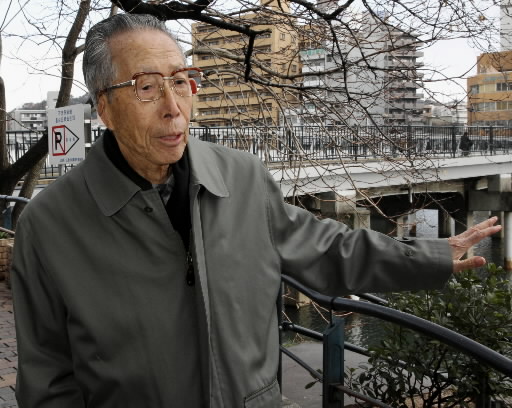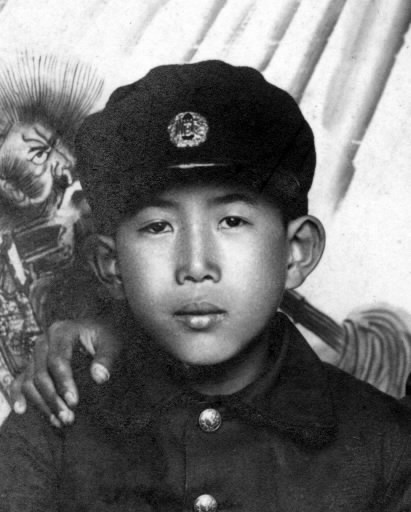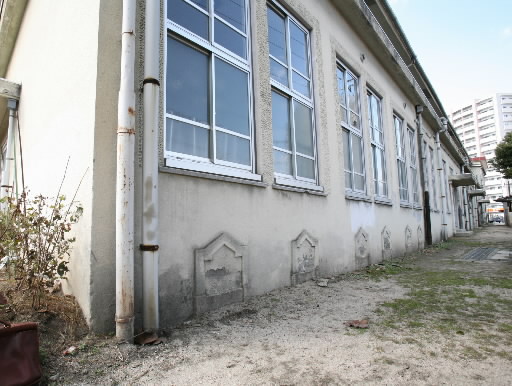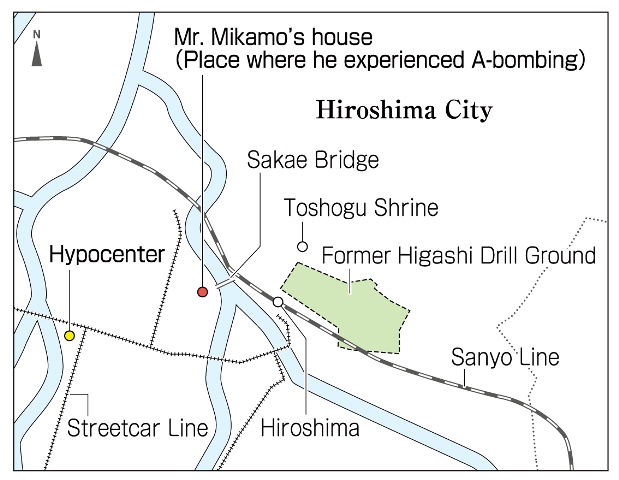Shinji Mikamo, 87, Higashi Ward, Hiroshima
Jan. 10, 2014
Lost his family and home in the war
Bounced from house to house, went into business for himself
When Shinji Mikamo, 87, lost everything to the atomic bomb, including his family and his home, he was reminded of a Japanese proverb: “Trust takes ten years to build, but can be lost in a single moment.” Ever since, these words have echoed in his mind.
Mr. Mikamo was 19 when the atomic bombing took place. After he graduated from Hiroshima City First National School (now, Danbara Junior High School in Minami Ward), he began working at the Hiroshima Army General Depot (in Minami Ward). At the same time, he continued his studies and also served at the headquarters of the Second General Army.
When the A-bomb exploded, on the morning of August 6, 1945, he was at home in Kamiyanagi-cho (part of present-day Kaminobori-cho in Naka Ward, about 1.2 kilometers from the hypocenter). To create a fire lane in the event of air raids, he was helping to dismantle his house. He was on the roof, removing roof tiles to take them to the spot where the house would be rebuilt.
Suddenly a yellow ball of fire, three times as large as the sun, filled his vision. At the same instant, he felt a blast of intense heat, as if splashed with boiling water. The next moment, he was being blown through the air and he landed in a neighbor’s yard, his house toppling down on him. His father, Fukuichi, pulled him from the wreckage, but his pants had caught fire and he suffered a serious burn to his right thigh. He was also burned and wounded on his back, right arm, both hands, and face.
They fled toward Sakae Bridge (in today’s Naka Ward), and spent that night beside the river near Sentei, a large Japanese garden now known as Shukkeien. The following day, August 7, they went to the Higashi Drill Ground, on the north side of Hiroshima Station, and waited there for about three hours under the blazing sun to receive medical care. They spent the next couple of days at Toshogu Shrine (in Higashi Ward) and at the wreckage of their house, then headed to a temporary relief station at Fuchu National School (today’s Fuchu Elementary School) on August 9. On August 11, an older colleague from the military came looking for him at this relief station. At this point, he parted from his father and went to a military facility.
He then spent time at various locations, including Kanawajima Island (in Minami Ward), Koyaura National School (Koyaura Elementary School in Saka) and the Ujina Branch of the Hiroshima First Army Hospital (in Minami Ward). About one month after the bombing, he began to lose his hair and he suffered from a high fever, diarrhea, and a falling white blood count, to one-tenth of the norm. However, after receiving injections, his condition improved.
Mr. Mikamo left the Army Hospital on October 20 and went in search of his father, but wasn’t able to find him. Even today, his father’s whereabouts are unknown. His mother, Nami, who went to a relative’s house in Okayama Prefecture to recuperate, passed away that September. In 1946, he received notification that his brother, Takaji, who was three years older, had died in battle in the Philippines.
After losing everything, Mr. Mikamo stayed at the homes of co-workers and friends. He then went into business for himself, making use of the electrical engineering skills he had learned at the Army General Depot to repair radios. Eventually he was offered various jobs by Michimasa Kubo, the founder of Daiichi Sangyo (today’s Edion Group, one of Japan’s largest retail chains of consumer electronics), and steadily grew his reputation and his achievements. Today, Mr. Mikamo is still engaged in manufacturing power transformers.
In the year marking the 60th anniversary of the atomic bombing, he donated books to Koyaura Elementary School to express his gratitude for the help he received in the aftermath of the atomic bombing. “I was saved, given the chance to live,” he said. “So I want to contribute something to society as long as I’m alive.” Mr. Mikamo hopes that young people will oppose war and promote peace. (Rie Nii, Staff Writer)
Hiroshima Insight
Hiroshima City First National School: Expanded after the war and used for industrial arts
Today’s Danbara Junior High School, located in Minami Ward, was known as Hiroshima City First National School during the war. Students who completed six years at a national primary school, equivalent to the present-day elementary school, went on to the national school for two years.
The school was built in Danbarayamasaki-cho in 1932, about 600 meters north of its current location, and named Hiroshima City First Advanced Elementary School. In 1941, in line with the National School Order which enforced a military-edged education, the name was changed to The First National School.
The school was located about 2.6 kilometers from the hypocenter. The A-bomb blast destroyed the north school building, made of wood, and the window frames, and glass, in the auditorium, as well as the east and west buildings, were smashed. In the aftermath of the bombing, the east school building and the auditorium served as makeshift relief stations.
About 650 students from the school had been mobilized to work for the war effort, so very few were on the grounds that day. Around 50 of the roughly 150 students who were helping to dismantle buildings to create a fire lane in Showamachi (part of present-day Naka Ward) are believed to have died in the blast.
After the war, a second floor was added to the single story ferroconcrete east school building. Until April 2011, when Danbara Junior High School was moved to its current location, the building was long used as a space for industrial arts.
Teenagers’ Impressions
Spread the idea “No war”
Mr. Mikamo told us, “I want you to have an anti-war spirit.” I think this desire comes from his experience of losing his older brother in the war and his father in the atomic bombing.
Although Japan today is blessed to have peace, conflict and war continue in other parts of the world. I want to spread the idea that there should be no war, that all war should stop. (Miyu Okada, 12)
Never forget the kindness of others
Mr. Mikamo still clearly recalls the kindness that a number of people showed to him after the atomic bombing. Sixty years later, he donated a lot of books to the elementary school in Saka, in Hiroshima Prefecture, where he was recuperating from his injuries.
Like Mr. Mikamo, I want to remember the kindness I’ve received in my life and gladly give back to others. (Satsuki Kunimoto, 17)
Staff Writer’s Notebook
The spot where Mr. Mikamo’s right ear should be is flattened skin. “People stare at it, but there’s nothing I can do. If I were them, I would stare, too.” In the aftermath of the bombing, he developed perichondritis and his ear was surgically removed while at the Ujina Branch of the Hiroshima First Army Hospital. Because of the shortage of medical supplies, he underwent the operation without anesthetic, having given his dose of anesthetic to the woman lying next to him, whose body was covered with piercing glass fragments. Looking back, he said, “I lost my right ear, but I managed to hold onto my humanity.”
After the war, despite losing his family and surviving alone, he maintained that sense of humanity, never stealing from others. The words of his father echoed in his mind: “Even in tough times, you can’t resort to crime.” After he left the Army Hospital, he stayed with relatives, and then was asked to move into a small room in a neighboring house. A younger friend visited him there with a pumpkin, saying, “Here’s our breakfast tomorrow.” But Mr. Mikamo suspected that the pumpkin wasn’t his friend’s, and in fact, his friend had stolen it. The next morning, they discovered that a mouse had chewed into the pumpkin during the night. “This is our punishment,” Mr. Mikamo said, but his friend hurled the pumpkin against the wall. Mr. Mikamo added that, later, this friend became the boss of a criminal gang.
Mr. Mikamo experienced the bombing at the age of 19, so he recalls the conditions vividly, and can remember a variety of episodes. His daughter, Akiko, who lives in the United States, wrote up his experiences and published them in a book titled Rising From the Ashes, released in English this past summer. They plan to publish the book in Japanese as well, and I would highly recommend reading it. (Rie Nii)
(Originally published on December 23, 2013)











